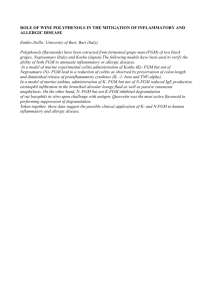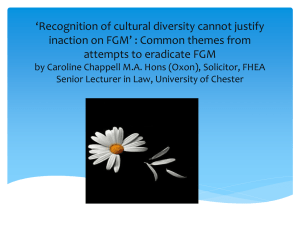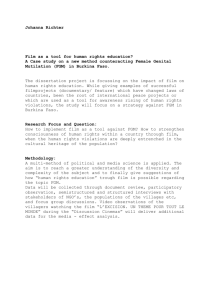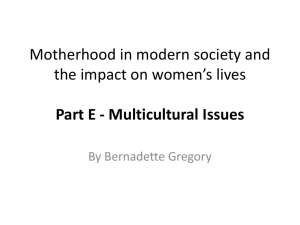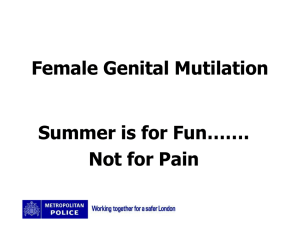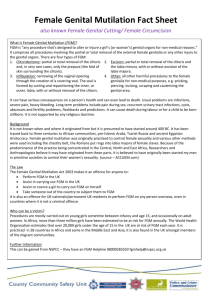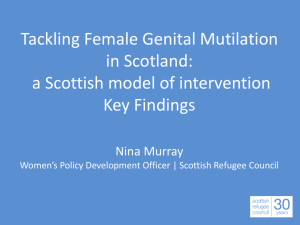FGM: Definition, Types, Complications & CMFT Action Plan
advertisement
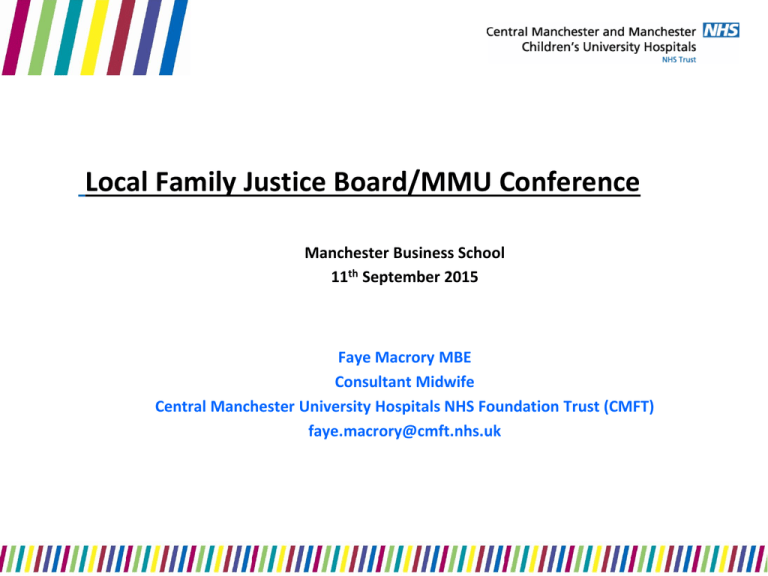
Local Family Justice Board/MMU Conference Manchester Business School 11th September 2015 Faye Macrory MBE Consultant Midwife Central Manchester University Hospitals NHS Foundation Trust (CMFT) faye.macrory@cmft.nhs.uk the starting point…………… FGM is the manifestation of gender inequality that is entrenched in social, economic and political structures. FGM is a form of violence against women and girls. (WHO 2008) FGM Act (2003) It is an offence to excise, infibulate or otherwise mutilate the whole or any part of the labia majora, labia minora or clitoris of another person for non medical reasons, or to aid, abet council or procure any of these acts on that person’s own body. It is also an offence to take a child out of the Uk for that purpose or to arrange it. The penalty is up to 14 years imprisonment. Where is FGM performed? • FGM is practiced in over 28 African countries • Parts of the Middle East, Yemen, Syria. in N. Iraq and other Kurdish areas • Reported among Bhora Muslims in Pakistan, India and East Africa, Indonesia, Malaysia, Papua New Guinea • Is increasingly encountered among migrant populations in the UK, Europe, USA, Canada, Australia and New Zealand Classification of FGM FGM/C (also called cutting) comprises all procedures that involve partial or total removal of the external female genitalia, or other injury to the female genital organs for non medical reasons (WHO 2008) Terms used: e.g. sunna, kakia, bundu, tara, tahur:- meaning purification Type 1: Clitoridectomy: partial or total removal of the clitoris Type 2: Excision: partial or total removal of the clitoris and the labia minora with or without excision of the labia majora Type 3: Infibulation: narrowing of the vaginal opening through the creation of a covering seal, repositioning outer and inner labia with, or without removal of the clitoris Type 4: All other harmful procedures to the female genitalia for non-medical purposes e.g. • pricking • piercing • incising • scraping • cauterizing the genital area • pulling/stretching the labia and clitoris what about cosmetic surgery?? Why the practice continues: • • • • • • • • • custom and tradition mistaken belief that FGM is a religious requirement preservation of virginity/chastity social advantage, especially for marriage enhancing fertility hygiene and cleanliness increasing male sexual pleasure family honour sense of belonging to a group vs fear of social exclusion (WHO 2008) Short term complications of FGM • • • • • • • haemorrhage shock acute urinary retention damage to other organs infection failure to heal death Long term complications of FGM: • • • • • • • • difficulties passing urine/UTI’s HIV, Hep.B menstruation difficulties chronic pelvic infection infertility vulva abscess/cyst/calculus/neuroma keloid scarring/fistula increased risk during delivery e.g. perineal trauma, PPH and perinatal death • sexual, psychological and psychosexual difficulties Health Many opportunities to identify women affected and girls at risk particularly in: • • • • • • A&E/ED maternity and gynaecology female surgery urology/continence team SARC, GUM, CASH GPs, HVs, School Nurses CMFT Action Plan Key aspects in managing FGM: • provision of sensitive & appropriate services to all women identified with FGM • availability of physical and psychological support • safeguarding infants and girls at risk of FGM Progress do far: • Trust Lead nominated for FGM Agenda • FGM Steering Group established • Online Data collection tool developed and implemented Trustwide. Enhanced Data Set Mandate from April 2015 • FGM standing item on CMFT Adult & Children’s Safeguarding Groups • Representation on local and regional forums • Presenting at local and national conferences • Distribution of resources • Training sessions across CMFT • Expertise of the specialist MW (refugee/asylum seekers) • Recognition of unmet psychological/mental health needs • Community engagement identified e.g. SOS Clinic (NESTAC) • Early referral to SMH Warrell Unit re de-infibulation • • British Journal of Midwifery Awards March 2015 Nursing Times Awards November 2015 Useful websites • • • • • • • • • • • • • www.fgmnationalgroup.org www.rcm.org.uk www.who.int/ www.amnesty.org.uk www.fgmnetwork.org www.equalitynow.org www.dofeve.org www.nspcc.org.uk www.endthefear.co.uk/practitioners www.afruca.org www.forwarduk.org.uk www.nestac.org www.fgmelearning.co.uk Key publications Data collection: www.hsic.gov.uk/isce/publication/scci2026 Education/e-learning: http://www.elfh.org.uk/programmes/female-genital-mutilation/ Safeguarding: https://www.gov.uk/government/publications/safeguardingwomen-and-girls-at-risk-of-fgmwww.hsic.gov/fgm/fgm Commissioning services: https://www.gov.uk/publications/services-for -women-andgirls-at-risk-of-fgm GP Practices CAP registration: www.hsic.gov.uk/fgm https://www.gov.uk/government/consultations/consultation-on-thedraft-statutory-multi-agency-practice-guidance-on-female-genitalmutilation-fgm. Recent developments: The Serious Crime Act 2015 strengthens the law around FGM by extending the extra-territorial jurisdiction of the offence. In summary: • • • • extends the extra-territorial reach of FGM offences and providing anonymity to victims a new offence of failing to protect a girl under 16 from the risk of FGM provision for FGMPO to protect victims and likely victims mandatory reporting - new duty on professionals to notify the police of acts of FGM Any questions?
